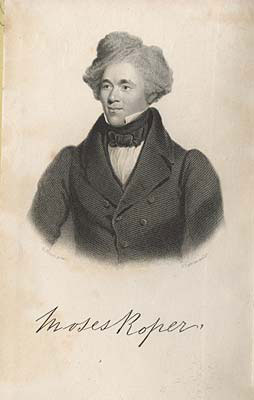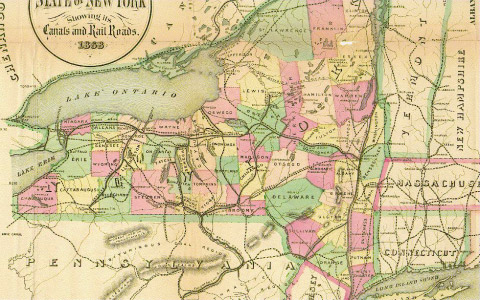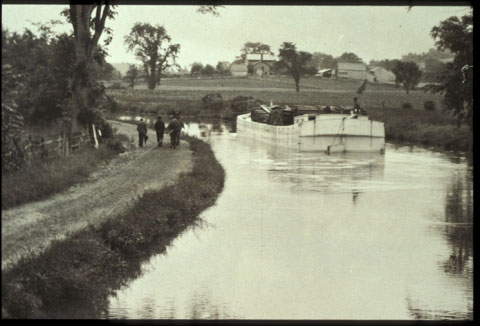For fugitive slaves who entered Canada on Northeastern New York's waterways to freedom, Lake Champlain was a Gateway to Freedom.
Many of the men, women and children on their way to New York were secreted in Philadelphia, and then forwarded to New York City. From there they were forwarded into New England or through the Hudson River Valley to the Capital Region (Albany and Troy). They were forwarded from the Capital Region through two natural geographical corridors. The first stretched westward across the center of the state to Canada West by way of Syracuse, Rochester, Buffalo and Niagara Falls. (At Syracuse, some fugitives were sent to Oswego.) The other extended northward to Lake Champlain and Canada East.
Movement of the self-emancipated to Lake Champlain was facilitated in 1823 with the inauguration of the Champlain Canal which connected the lake to the Hudson River. Freedom seekers were now able to proceed up the Hudson River, into the Champlain Canal and then down Lake Champlain to Canada.
The Lake Champlain corridor was the most direct route to freedom from Albany and Troy.
Sources:
1868 color map of New York canals and railroads. University of Rochester, Department of History. 2 April 2009.
Champlain Canal, 1895 photo by Howard Pyle, courtesy Ray Allard.
Stories
Stories of fugitive slaves who traveled on Lake Champlain illuminate the lake's importance to the Underground Railroad.
A Narrative of the Adventures and Escape of Moses Roper, from American Slavery is the earliest known account.
Moses Roper

Moses Roper was born in Caswell County, North Carolina, about 1815 on a day and in a month he never knew. He was the son of an enslaved woman named Nancy, who was part African and Indian, but mostly white, and plantation owner Henry Roper. A few months before Moses' birth, his father married his mother's young mistress. She was so angry that Moses looked like her husband, she tried to murder him with a knife. Just as she was about to stab Moses, his grandmother grabbed the weapon and saved his life.
When he was about six or seven years old, Moses and his mother were sold to different masters. He was subsequently resold several times. He ran away repeatedly, but he was always captured and punished. Finally, in 1834, he escaped from Savannah, Georgia, on a ship which was headed for New York.
Roper wrote,
...When I arrived in the city of New York, I thought I was free; but learned I was not, and could be taken there. I went out into the country several miles, and tried to get employment, but failed, as I had no recommendation. I then returned to New York, but finding the same difficulty there to get work as in the country, I went back to the vessel, which was to sail eighty miles up the Hudson River, to Poughkeepsie. When I arrived, I obtained employment at an inn, and after I had been there about two days, was seized with the cholera, which was at that place...
As soon as he regained his health, Roper took a steamboat to Albany where he hired out as a steward on an Erie canal boat. After going west 350 miles, he felt increasingly unsafe, so he returned to Albany, boarded a Champlain Canal packet boat and headed for Vermont. In the Green Mountain State, Roper worked as a field hand until he saw a newspaper advertisement for his capture. He went east to New Hampshire, where he stayed briefly before moving on. In Boston, he affiliated with abolitionists and signed the constitution of the American Anti-Slavery Society. By late 1835, however, his fear of being captured grew so intense he decided to leave the United States. Retracing his steps back through Vermont, he hid for a short time, and then went to New York City, where he boarded the Napoleon for Great Britain. In Liverpool, Roper presented a letter of introduction to British abolitionists, who warmly welcomed him. He then went to London, where he began to obtain a formal education. Roper published his narrative in the summer of 1837, and he gave hundreds of lectures in English and Scottish churches. In 1839, he married an Englishwoman from Bristol, Ann Stephens Price. In 1844, they sailed for Canada.
Moses and Ann Roper have many descendants living in Australia.
Sources:
Map of New York, Fannings Illustrated Gazetteer of the United States (New York: Ensign, Bridgman, & Fanning, 1854).
Moses Roper, Narrative of the Adventures and Escape of Moses Roper, from American Slavery. Berwick -upon-Tweed: Published for the author and printed at Warder Office, 1848. Documenting the American South. University Library, The University of North Carolina at Chapel Hill. 3 February, 2009. UNC-Chapel Hill University of North Carolina at Chapel Hill, 2004. http://docsouth.unc.edu/neh/roper/summary.html








